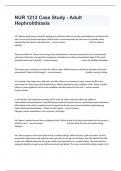Summary
Summary Macroeconomics: A European Perspective - Olivier Blanchard - All chapters - 9781787265417
- Course
- Institution
- Book
This is a compact summary of Macroeconomics: A European Perspective by Blanchard the 2018 edition. ISBN 9781787265417. The entire book is summarized in plain English with the same layout. All important calculations are present. Our study group used this summary throughout the course, making underst...
[Show more]













